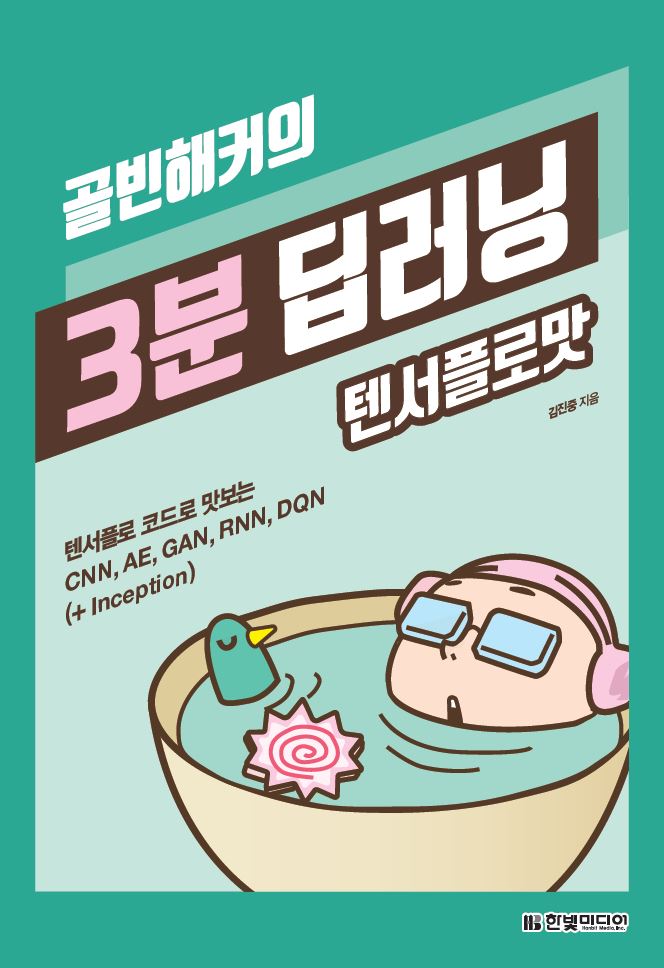We provide source code that allows you to practice TensorFlow step by step from basics to application.
It covers most of the content in the guide provided on the official TensorFlow site, and is much more concise than the source code provided on the official site, so you will be able to easily learn the concepts. Also, all comments are in Korean(!).
However, since the focus was on learning the basic concepts of various techniques and models and how to use TensorFlow rather than a deep understanding of the theory and accurate implementation, please consider that there are many areas where the implementation is insufficient.
Also, I would appreciate it if you could refer to the code and comments so that you can understand it in a sequential flow rather than creating beautiful code.

Thanks to the many people who showed interest in this repository, I organized the annotations, added explanations, and published a book titled 『Golbin Hacker's 3-Minute Deep Learning』 (Hanbit Media, 2017).
Rather than delving deeply into the theory, we focused on learning the basic concepts of various deep learning models and how to use basic TensorFlow. Therefore, I think it will be especially helpful for developers who are new to deep learning/machine learning.
Of course, it's even better for decoration. ^_^b
Yes24 | Kyobo Bookstore | Aladdin
As a person studying deep learning, I have read quite a few original books, domestic translations, and materials, but I have never seen anything that explains the key points in such a concise and practical way. While other books usually stop at explaining CNN models, this book approaches major deep learning models, including RNN, DQN, and autoencoder, with practical examples, providing a good direction for those studying deep learning. I highly recommend this book as a must-have book for anyone starting deep learning.
Byeong-wook Cho (Daehyeop Cho), Google Korea cloud engineer, author of 『(Daehyeop Cho's server side) large-capacity architecture and performance tuning』
“Artificial intelligence is the electricity of a new era.” Dr. Andrew Ng, the world's leading authority on deep learning, expressed the future value of AI as follows upon leaving Baidu. This means that AI is no longer a research activity for a few scientists, but has become a technology that anyone can comfortably use in everyday life, like electricity. In fact, this book explains well that deep learning, the core of AI, is an electrical technology that anyone can use comfortably. CNN, the silver bullet of image recognition, GAN, the hottest potato in 2016, RNN, representative of natural language recognition, and DQN of Google's Deep Mind represented by AlphaGo... It is a somewhat difficult abbreviation at first glance, but as you slowly go through the example code in this book, If you follow along, anyone will be able to easily understand what the technologies representing the field of artificial intelligence actually are through friendly explanations. After reading the last chapter of this book, I agree with Andrew Ng even more. I am confident that this book will be a good guide for those who want to make good use of electricity.
Park Sang-gil, Kakao New Search Development TF Head
I thought that I could approach deep learning in such a fun way. It's neither too light nor too academic. I believe that the process of creating one by one and well-organized code will be a milestone for those who are new to this field.
Seo Min-gu, Google Korea software engineer, author of 『Data Processing & Analysis Practice Using R』
Detailed code-centered explanations and basic concepts established in easy terminology! This is a book that provides guidance for developers who are unaware of deep learning when setting sail into the sea of deep learning. I would like to recommend this to my wife who is about to jump into the world of deep learning!
Ha Jeong-woo, Naver Clova AI Research Team Leader
issuu | SlideShare
Let's use Inception, a neural network model developed by Google that is excellent for image recognition.
Without having to implement a neural network model yourself, you can immediately apply a program with an excellent recognition rate to practice using your own data by simply writing a simple script.
For more information, please refer to document 11 - Inception/README.md.
Let's implement DQN, a reinforcement learning using deep learning developed by Google's DeepMind, famous for AlphaGo.
It may seem a little complicated, but I've separated the key parts as much as possible, so you'll be able to follow along.
For more information, please refer to document 12 - DQN/README.md.
For more basic theory, please refer to the following courses and repositories.
~/.matplotlib/matplotlibrc file and add the setting backend: TkAgg .